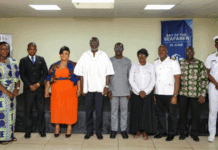The deputy Minister of Lands and Natural Resources, George Mireku Duker, has lauded the significant progress of the natural resource governance framework in recent years, citing regulatory reforms – particularly institution of the Fiscal Responsibility Act and Minerals Income Investment Fund Act.
The country’s gold mining sector surged from a total score of 56 out of 100 points in 2017 to 69 out of 100 points in 2020, according to the Resource Governance Index report released by the Natural Resource Governance Institute. The report also saw the revenue management sub-component increase from 37 percent in 2017 to 54 percent in 2020, indicating that government has made notable progress in managing mineral resources.
Mr. Duker spoke at the 2020 Mining and Oil/Gas Extractive Industries Transparency Initiative (EITI) reports launch in Accra, and hailed government’s efforts to promote transparency in the extractive industries. He stressed that the reports are a testament to the country’s commitment to adhering to global best practices in resource governance to ensure the equitable distribution of benefits derived from natural resources.
He noted that while the achievement is significant there is still room for improvement, and that government remains steadfast in its pursuit of continuous improvement, strengthening regulatory frameworks and addressing emerging issues.
Ghana’s mining policy document, adopted in 2016, is currently under review to incorporate contemporary developments and highlight the mining sector’s significance as a potent economic pillar for growth on a strong and sustainable basis. The mining policies are designed to control mining activities based on Ghana’s mineral exploration potential, adopting robust geoscientific information systems, and creating investor-friendly legal and regulatory frameworks. The primary goal is to develop a well-structured mining sector that contributes to attaining sustainable and strategic development objectives, reducing poverty, creating employment opportunities for youth, and promoting economic growth.
To pursue this objective, the Ministry of Lands and Natural Resources says it is strengthening the capacities of beneficiary agencies under the six-year Ghana Landscape Restoration and Small-Scale Mining Project to adopt current technologies and innovative principles.
The ministry believes that by so doing, the disclosure of information will enhance EITI reporting in the coming years. The ministry is also advocating mainstreaming the informal Artisanal and Small-Scale Mining (ASM) sub-sector to better support management of the mineral revenue.
The key findings from the 2022 EITI Mining and Oil/Gas reports revealed that the oil and gas sector contributed 3.7 percent to Ghana’s gross domestic product (GDP) in 2020. However, the sector recorded a growth rate of -4.6 percent (at constant 2013 prices) due to lower petroleum receipts, which were US$666.39million compared to US$937.58million in 2019. On the other hand, the mining and quarrying sector’s share of Ghana’s GDP marginally reduced from 7.8 percent in 2019 to 7.6 percent in 2020. The total volume of gold produced declined from 4.577 million ounces in 2019 to 4.023 million ounces in 2020, representing a downturn of 12 percent.
The volume of manganese produced tumbled from 5.383 million tonnes in 2019 to 2.358 million tonnes in 2020, representing a decrease of 56 percent. However, the volume of bauxite produced increased from 1.116 million tonnes in 2019 to 1.162 million tonnes in 2020. Finally, receipts from the export of minerals represented 48.4 percent of the country’s total merchandise export revenue in 2020, with crude oil and cocoa contributing 20.1 percent and 16.1 percent respectively.
The Multi-Stakeholder Group of the Ghana Extractive Industries Transparency Initiative (GHEITI), a tripartite body comprising government, industry and civil society, has hailed the reports for going beyond mere reconciliation of payments and receipts. They also include contextual information such as the legal framework and fiscal regime, the sector’s contribution to the economy, production and export data, state-participation in the extractive industries, revenue allocations and sustainability of revenues, licence registers and licence allocation.










